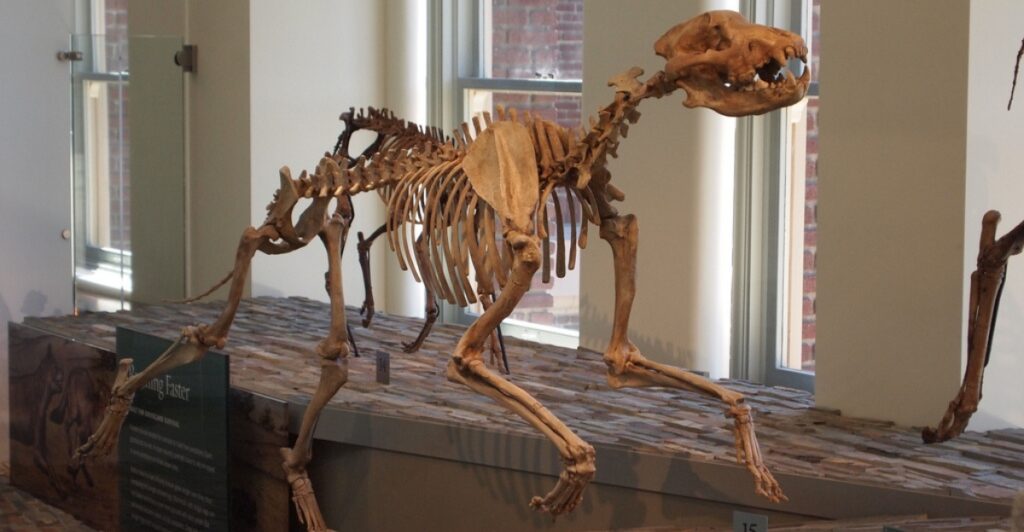
In the sprawling plains of ancient North America, a predator once ruled with unmatched size and strength—Epicyon haydeni. Often described as “more than a dog,” this extinct canid was the largest of its kind, overshadowing today’s wolves.
Living between 12 and 6 million years ago, it resembled a bear more than a modern dog, complete with bone-crushing jaws. Recent reconstructions reveal Epicyon’s immense size—up to 2.4 meters (7.9 feet) long and weighing as much as 170 kilograms (375 pounds). Its brute strength and fearsome bite made it a dominant force during the Late Miocene to Early Pliocene.
Scientists continue to study this evolutionary marvel, captivated by how such a powerful predator managed to thrive for millions of years across prehistoric North America.
The Skull That Crushed Bones: Built for Power
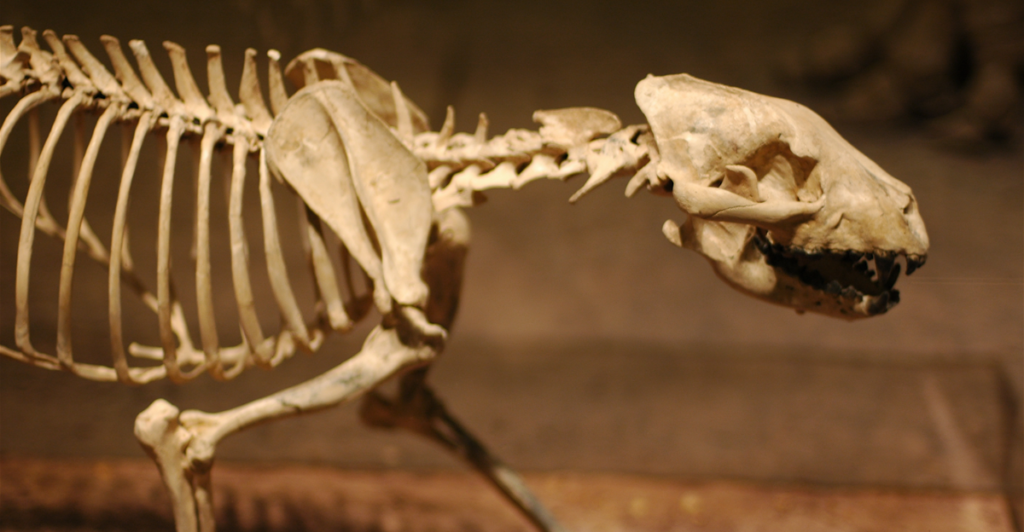
Epicyon belonged to the extinct Borophaginae subfamily—often referred to as “bone-crushing dogs.” Unlike modern canids, its skull resembled that of a lion, complete with a domed forehead and a shortened snout that amplified bite force.
Key adaptations included enlarged premolars and carnassials, allowing it to crush bones and access marrow no other predator could. This ability gave Epicyon a distinct survival edge. With a shoulder height of 90 cm (35 inches), it towered over modern wolves.
Fossils discovered across North America have revealed a powerful build—muscular limbs and robust jaws designed for overpowering prey and intimidating rivals. These skeletal clues paint a portrait of a predator finely tuned for both hunting and domination, thriving in a highly competitive, predator-rich environment for millions of years.
How Epicyon Hunted: Fast, Fierce, and Tactical
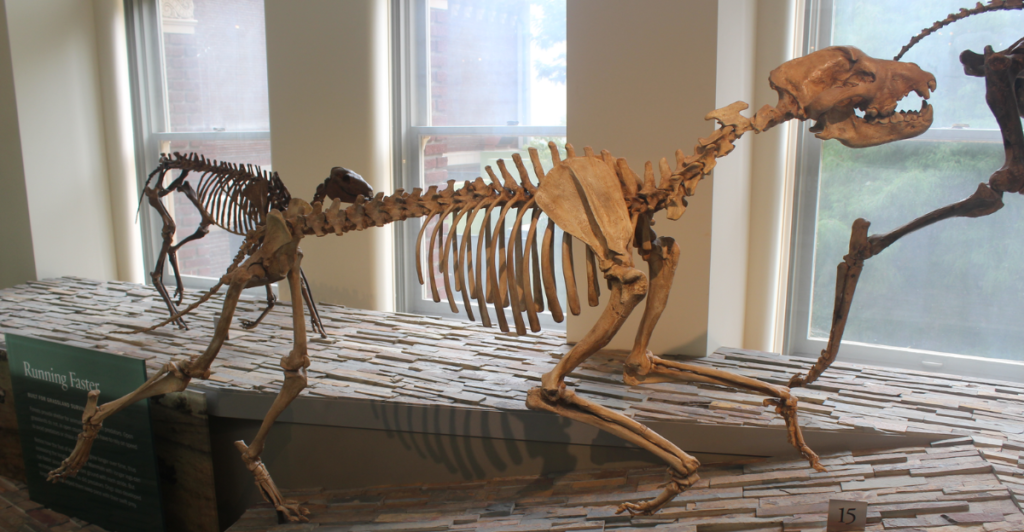
Once thought to be mainly a scavenger, Epicyon is now seen as a capable hunter with surprising agility. It didn’t chase prey over long distances like today’s wolves. Instead, it relied on quick bursts of speed to ambush unsuspecting herbivores.
Its skeletal frame suggests it was more mobile than most borophagines, though not as built for endurance as wolves or hyenas. Unlike big cats that subdue prey with claws, Epicyon’s hunting relied entirely on powerful jaws and close-positioned canine teeth designed for bone-breaking strikes.
This lethal approach enabled it to bring down large prey including prehistoric camels like Aepycamelus, horses, and even rhinos like Teleoceras. Its precision-based, high-impact style made it one of the most formidable predators of the Miocene era.
Eating Everything—Even the Bones
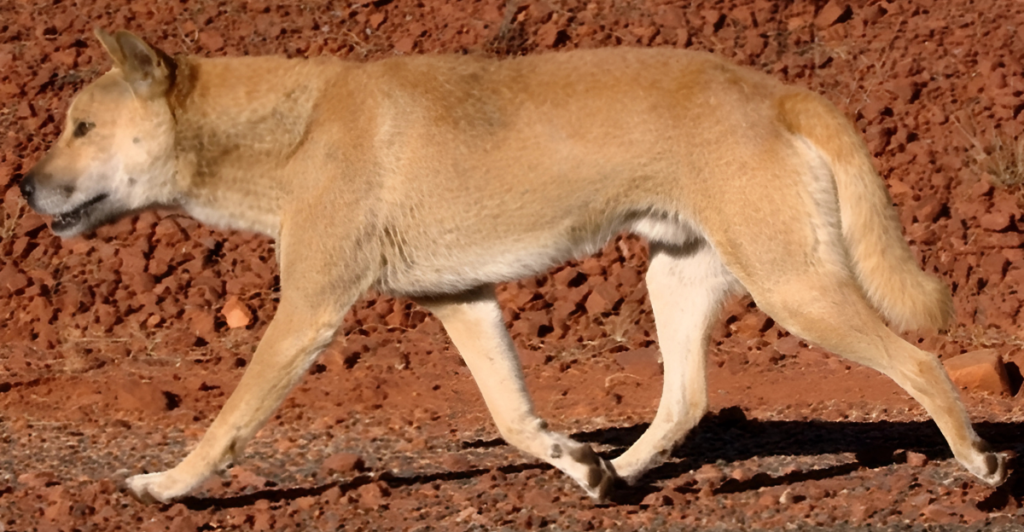
Epicyon’s strength wasn’t limited to its size—it also came from its ability to eat almost anything. As a hypercarnivore, more than 70% of its diet came from animal flesh, but it wasn’t limited to meat alone. Its strong molars could grind plant material, and fossilized droppings show it consumed insects and even bone.
Like modern hyenas, Epicyon could digest solid bone, giving it access to marrow—a calorie-rich resource few predators could reach. This dietary flexibility allowed it to outlast competition, especially during times when prey was scarce.
Epicyon’s wide-ranging menu gave it an edge across varied ecosystems, from the forests of Alberta to the subtropical regions of Florida. Its ability to extract nutrition from nearly every part of a carcass proved essential to its long reign.
Apex Predator of the Ancient Continent
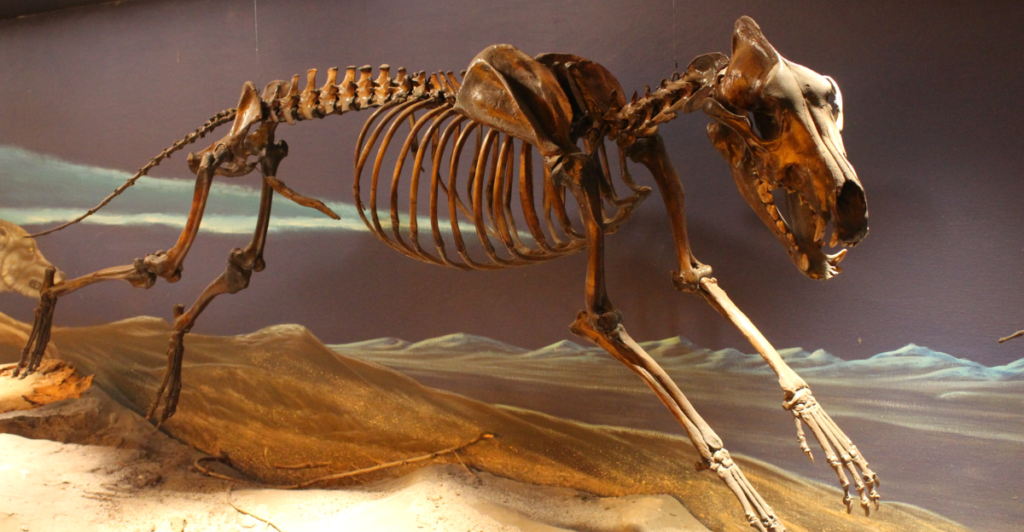
For about seven million years, Epicyon ruled as the top predator across prehistoric North America. Fossils uncovered from states like Florida, Nebraska, and California reveal its widespread dominance. Its immense bite force and bone-eating capabilities let it fill a role similar to that of modern hyenas, but with far greater size and power.
Epicyon’s influence stretched beyond hunting—its predation helped shape the evolutionary path of large herbivores, creating pressure that drove adaptation in prey species. Its constant presence loomed large for animals like early camels, horses, and pronghorns.
Even among other powerful carnivores of the Miocene, Epicyon stood out. Its presence in the fossil record offers clear evidence of its unparalleled ecological impact during one of the most biologically diverse periods in North American history.
Did Epicyon Hunt in Packs?
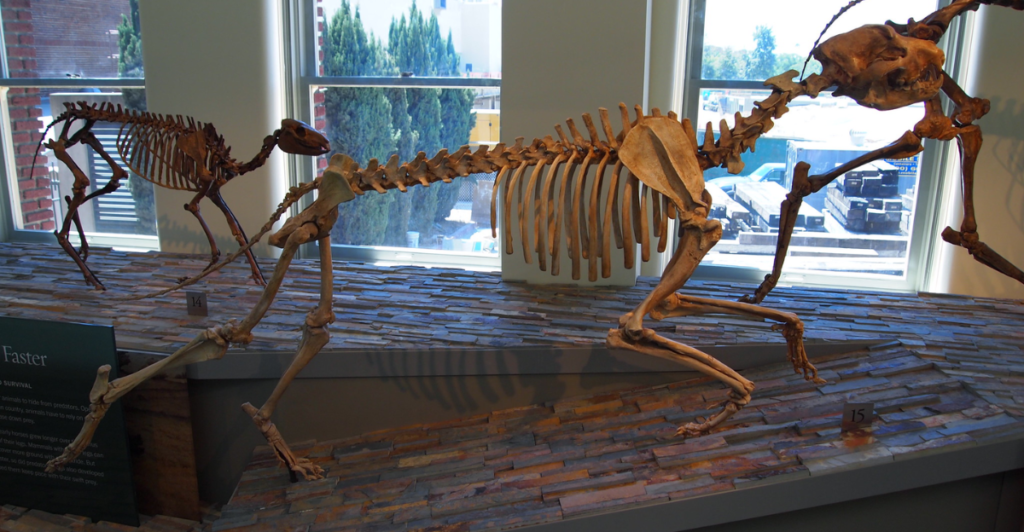
Whether Epicyon was a solitary predator or a social hunter remains an ongoing debate. Some scientists propose it hunted in packs, pointing to its ability to take down massive prey. Fossil distribution also suggests group-living may have been possible.
Others argue its skeletal traits—particularly its skull and forelimb structure—align more closely with solitary big cats. Its powerful jaws could either help an individual maximize food from a kill or enable group feeding. Without direct behavioral evidence, interpretations remain speculative.
The debate continues because Epicyon’s bone-crushing adaptations could support both solitary and cooperative strategies. Ongoing paleobiological research, including studies of fossil site patterns and wear on bones, may eventually help clarify whether this ancient predator hunted alone or as part of a coordinated pack.
Not Alone: Epicyon Faced Fierce Competition

Epicyon may have been the biggest, but it wasn’t the only carnivore on the block. It shared territory with formidable rivals like the massive bear Agriotherium, the sabertooth-like Barbourofelis, and the large cat Amphimachairodus coloradensis.
Even other borophagines like Borophagus were part of this predator-rich environment. Contrary to the outdated belief that cats replaced bone-crushing dogs, evidence shows borophagines like Epicyon thrived even after large felines had migrated to North America. The presence of multiple top predators suggests a diverse prey base and ecological niche differentiation.
Each species likely specialized in certain prey or hunting methods, reducing direct competition. Fossil evidence confirms that these predators coexisted for millions of years, contributing to a complex and dynamic food web shaped by both rivalry and adaptation.
From Discovery to Understanding: Scientific Journey
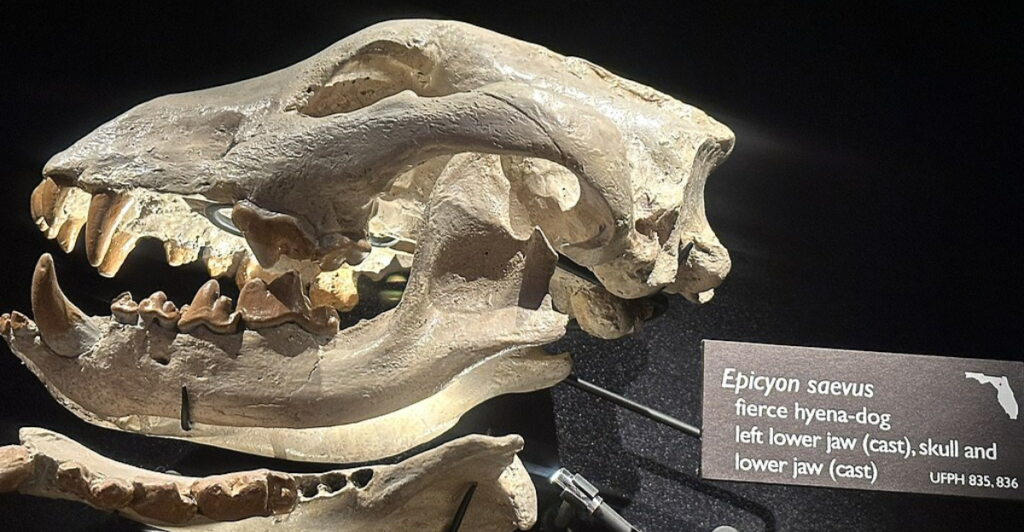
Epicyon’s story began in 1858 when paleontologist Joseph Leidy first identified it as a subgenus of Canis. Its classification evolved over time, with modern researchers firmly placing it within Borophaginae. The fossil-rich La Brea Tar Pits have been instrumental in preserving specimens for analysis.
Today, advanced tools like dental microwear studies, isotope testing, and CT scans help scientists explore Epicyon’s life in detail. These techniques reveal not just size and diet, but how it hunted and lived. By comparing bones across species and examining fossil wear patterns, researchers can now reconstruct behaviors and ecological roles.
Epicyon’s scientific journey underscores the power of paleontology to breathe life into ancient bones, expanding our understanding of extinct species and the ecosystems they once dominated.
Evolution’s Trap: When Specialization Goes Too Far
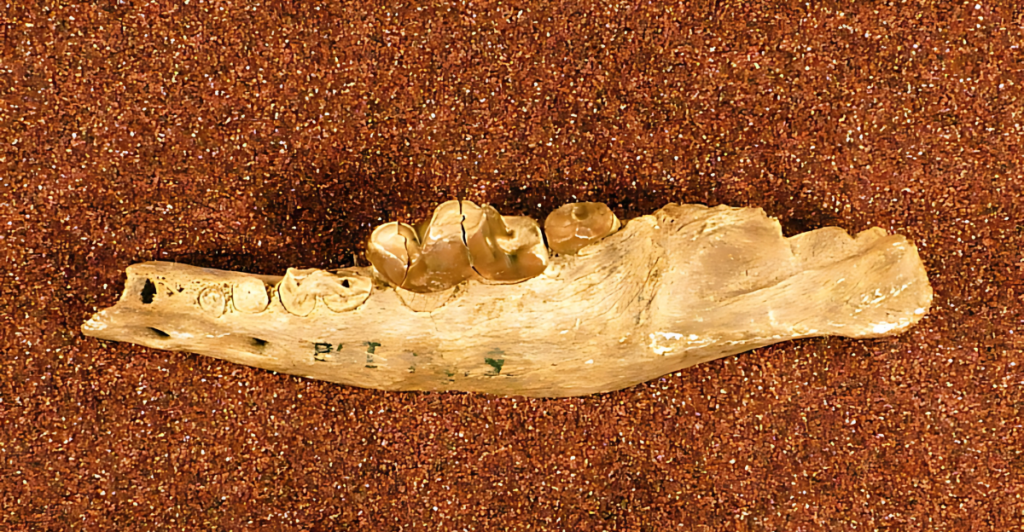
Epicyon exemplifies what scientists call the “hypercarnivore ratchet,” a pattern where predators evolve toward greater size and specialization, but at a cost. Over time, Epicyon and its kin became highly adapted apex hunters—powerful but inflexible. This specialization eventually became a liability when environmental shifts demanded adaptability.
As prey populations changed or dwindled, Epicyon’s narrow ecological focus made survival harder. It couldn’t pivot like more generalized predators. Though it represented the peak of borophagine evolution, this very success likely contributed to its downfall.
No modern dog descends directly from borophagines; instead, today’s canids evolved from more adaptable ancestors. Epicyon’s extinction highlights how evolutionary triumphs can also set the stage for collapse when circumstances change too quickly for highly specialized species to keep up.
Disappearance of a Titan: What Ended Epicyon?
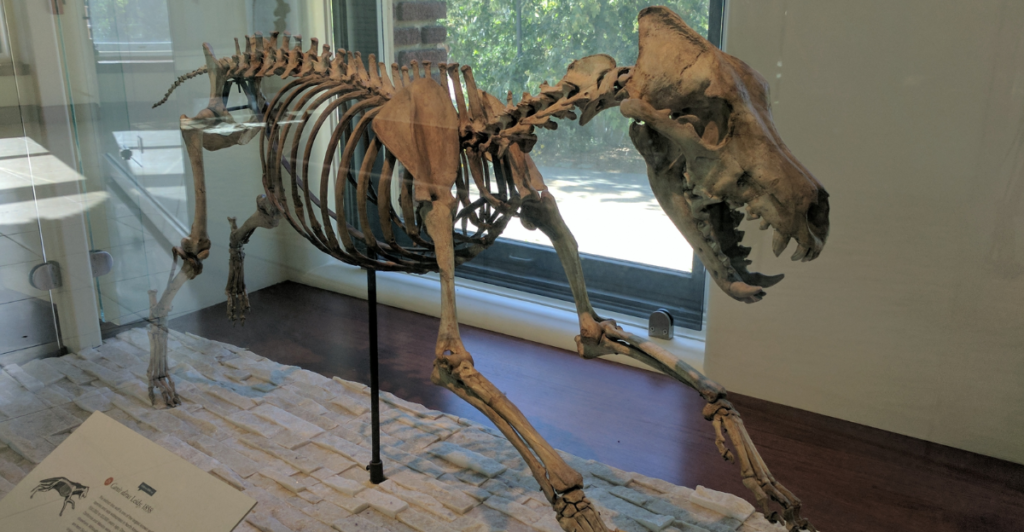
Around five million years ago, Epicyon vanished. While once blamed on competition from big cats, that theory no longer holds—fossils show cats and bone-crushing dogs coexisted for millions of years. Instead, environmental changes during the Miocene-Pliocene transition likely played a larger role.
Shifting climates, changing vegetation, and declining prey populations altered ecosystems across North America. Epicyon’s highly specialized adaptations, once a strength, became limitations in a rapidly transforming world. Unable to adjust, it disappeared along with other borophagines. Yet its legacy remains.
Epicyon offers critical insight into predator evolution, extinction dynamics, and ancient food webs. It stands as a towering example of nature’s complexity—of how even the most powerful species are ultimately subject to forces far beyond their control.
Explore more of our trending stories and hit Follow to keep them coming to your feed!

Don’t miss out on more stories like this! Hit the Follow button at the top of this article to stay updated with the latest news. Share your thoughts in the comments—we’d love to hear from you!







